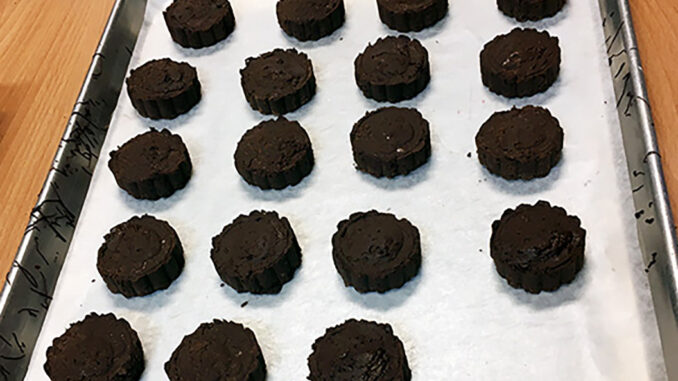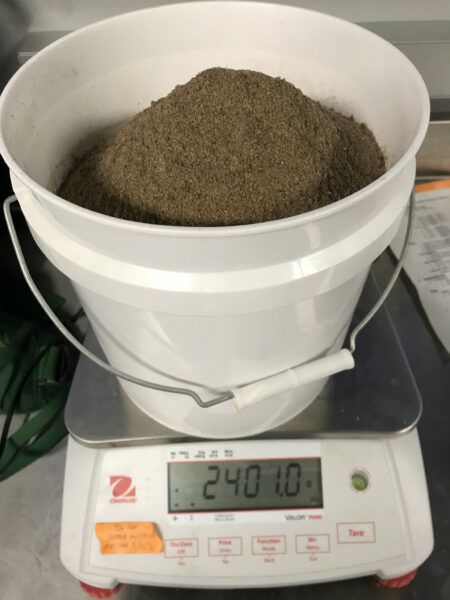
Mark Gokavi | the SOURCE
Take a food source that has twice as much protein as beef, double the iron as spinach, two times as much calcium as milk and way more vitamin B12 than salmon. Factor in that it’s cheaper, abundant, and more sustainable than other foods.
Add that it could help you maintain a diverse gut microbiota and reduce inflammation, among other health benefits. Oh, and cover it in artisan chocolate. It sounds approachable, even yummy. It could be the perfect food — if Americans get past the idea of eating insects.
Colorado State University researcher Tiffany Weir is working to remove the stigma against eating “bugs” by exploring the gut health benefits of insect consumption.

Weir will use chocolate patties made with cricket-derived chitin (kai’-tin), a type of fiber found in insect exoskeletons, in a study to explore the positive prebiotic effects of chitin on individuals with irritable bowel syndrome (IBS). The patties and a placebo version are being produced by Fort Collins’ own Nuance Chocolate.
“I don’t know that we can necessarily identify at what point people started eating insects,” said Weir, an associate professor in CSU’s Department of Food Science and Human Nutrition. “In this country, it’s hard to get people to accept consuming them on a regular basis. But in other cultures, it is a normal part of the cuisine.
“I first encountered them on a trip to China in a medicinal soup. It was a broth that contained a caterpillar infected by a cordyceps fungus. I ate the soup, but I avoided the caterpillar. I wasn’t as open-minded about food as I am now.”
Earlier research suggests benefits from crickets
Now Weir touts the benefits of consuming good bugs for both human and planetary health.
“Rearing and consuming insects can address climate issues and food insecurity since insect rearing isn’t very resource intensive,” she said. “Nutritionally, they are a good source of protein, they have omega-3 fatty acids, and the chitin is a source of fiber that isn’t found in other animal-based foods.”
Weir’s earlier research showed that gut health improved in adults eating 25 grams per day of ground-up crickets.
“We were the first researchers to ever do a human study looking at gut health-related benefits of insect consumption,” she said. “Now other scientists are starting to look at insect consumption and gut health. Some have looked at cricket consumption and microbiota in dogs, and others have taken insects and put them in model stomach bioreactors with human stool samples to see how that changes the microbiome.
“As far as I know, no one has replicated our feeding study, but most of the current research suggests gut health benefits.”
This prompted Weir and her colleagues to take the next step by determining whether the chitin from insects is responsible for these benefits.
Chitin is found in mushrooms, shellfish and insects. It is one of the most abundant polymers on earth, but large amounts don’t typically make it into human diets. Weir and her team are interested in determining if insect chitin can be utilized by gut microbes.
Sourcing cricket chitin proved to be the first hurdle the research team had to overcome. There are farms in North America that rear crickets for human consumption, but it was a bigger challenge to find isolated chitin.

Chitin extraction done at CSU

“We talked to places all over the world,” Weir said, naming off northern Europe, Russia and Singapore. One company could provide black soldier fly chitin, but not cricket chitin. “We wanted to stick with cricket since that was what we used in our first study. We decided that if we were going to do this with crickets, we’d have to do it on our own.”
Weir turned to a couple of CSU food science students to purify the chitin, which involved milling about 15kg of crickets into a fine powder and soaking it in a base-and-acid process to separate the materials.
Research Associate Paul Matthews, who now works in the Analytical Resources Core, and John Wilson, Weir’s Ph.D. student, used beer brewing equipment in the Gifford Building to accomplish the task.
“I had never done this before,” said Matthews, who added he ate “pretty tasty” deep-fried crickets in Thailand. “I learned from reading scientific literature and adapted the methods to our capabilities. … There is presumably increased interest in these kinds of processes as insects are making their way to market.”
To confirm the chitin identity, Matthews used different techniques such as circular dichroism and Fourier-transform infrared spectroscopy — a process to definitively identify compounds — to match the molecular fingerprint to commercial chitin from shrimp. Now the team had chitin for their study, but the next big challenge was how to determine how to deliver that chitin to participants.
Weir’s team used ground-up crickets incorporated into shakes and muffins in their first study.
“This introduced a dietary change for participants, since we were basically replacing their normal breakfast,” she said. “We had to be more careful in this study not to disrupt the normal diet too much and also had to be aware of food restrictions and triggers in our target study population. Capsules would’ve been ideal, but at a target dose of 4 grams of chitin that would require taking 15 capsules a day.”

Staying in town for chocolate patties

The team needed to formulate an intervention food that would increase acceptance of eating a product from insects and wouldn’t account for too much of the participants’ daily food intake.
To create a chocolate-based chitin intervention food — and the placebo version — Weir’s team turned to Nuance Chocolate at 214 Pine St. in Old Town.
“They called us and asked whether we could mix crickets in with chocolate,” said Toby Gadd, who along with his wife Alix are 50-50 partners running the factory and retail store. “And the first response was, you know, normally in chocolate we try to make sure we don’t have insects in it.”
Gadd was curious and, having a family member with chronic gastrointestinal issues, found the science interesting. He told CSU that it would be expensive for one of the country’s chocolate makers to produce, but after hearing the whole story, realized it was probably the best solution. “They sold me,” he said, adding that his machines are thoroughly cleaned after every batch.
“It’s not a small amount of chitin,” Gadd said. “So the question was, is it going to be tasty? And the answer is, yes, it’s good, and it doesn’t seem like something from crickets.”
A new prebiotic option
Wilson said the patties’ texture is like a Crunch bar and melts with chocolate on the back of the palate.
“The chocolate is pretty high in quality, so I largely tasted the chocolate the bars were made from,” Wilson said. “I don’t remember the cacao origin, but it tastes like a good quality chocolate bar.”
Wilson said he’s excited about the product and that prebiotics in a functional food may open more people up to prebiotic therapy.
“I also research edible insects, so high-quality products that help people debut insect eating are really exciting,” he said. “I think this product falls into that category. There is no discernable flavor or aroma; no spines, antenna, or legs to contend with; and no uncomfortable visual aspects to overcome when eating. You just get a high-quality chocolate bar that may positively impact your gut health.”
Both the chitin version and the maltodextrin control group have a ring of regular chocolate “en-robing” the outside, Gadd said. “It’s actually trickier than we thought. But we made it happen.”
Weir said the study timeline will be about 10 weeks from start to finish for each of the 20 or so IBS-diagnosed subjects and will be individualized to fit their schedule. Those interested can find more information here.
Support Northern Colorado Journalism
Show your support for North Forty News by helping us produce more content. It's a kind and simple gesture that will help us continue to bring more content to you.
BONUS - Donors get a link in their receipt to sign up for our once-per-week instant text messaging alert. Get your e-copy of North Forty News the moment it is released!
Click to Donate
